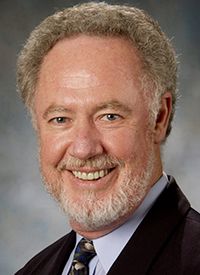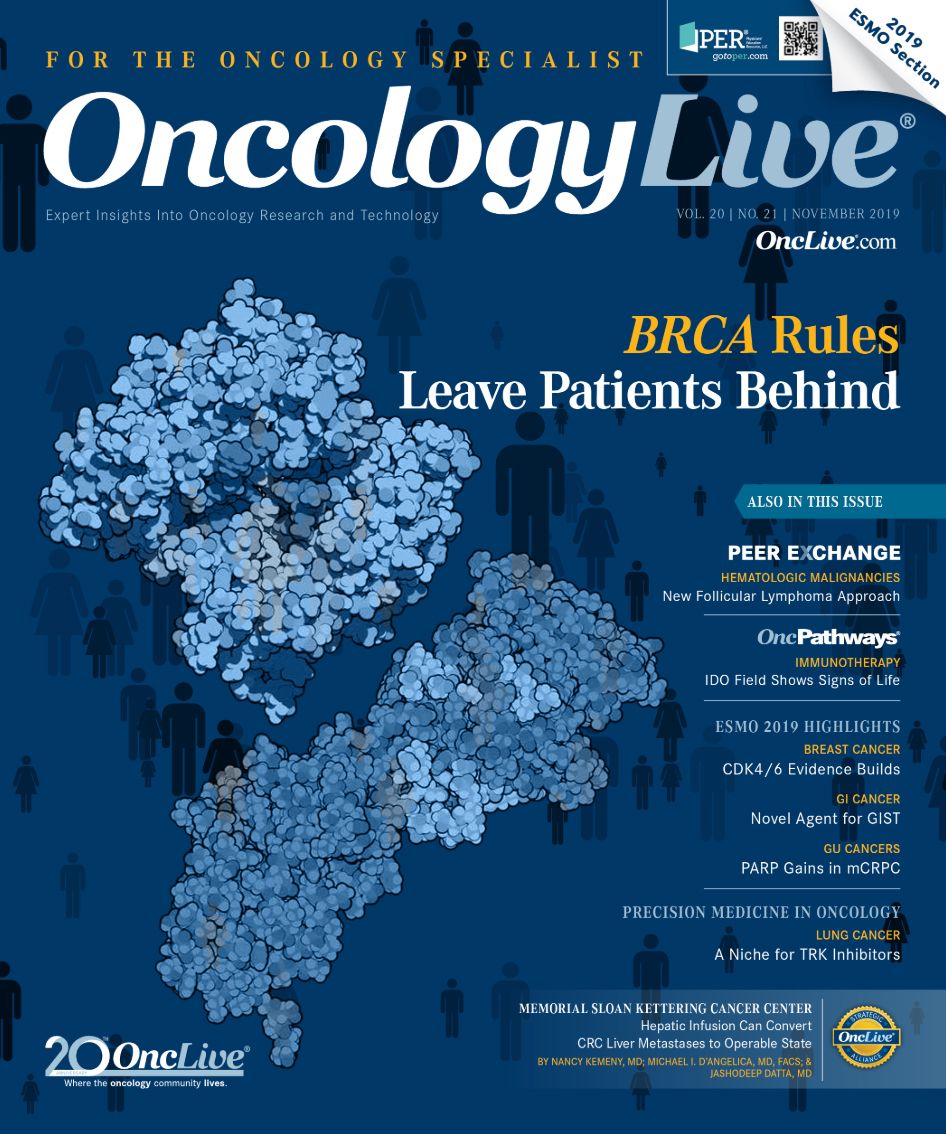Publication
Article
Oncology Live®
Taking CLL Therapies From Bedside to Community
Author(s):
Michael J. Keating, MBBS, has devoted much of his career to finding means of controlling chronic lymphocytic leukemia.
Michael J. Keating, MBB, Department of Leukemia at The University of Texas MD Anderson Cancer Center in Houston

Michael J. Keating, MBB
"I am an addict."
That is how Michael J. Keating, MBBS, describes himself and his pursuit of a cure for chronic lymphocytic leukemia (CLL). He acknowledges that investigators, like him, don’t do what they do in search of fame or glory or awards because that pursuit is a lot less important than the actual work that they do. Plus, his golf game is suspect, he doesn’t paint, and he doesn’t read “intelligent books.”
That leaves his work, to which he continues to devote 50 to 60 hours a week “in pursuit of my happiness, and that’s because I can’t think of anything that I do better than CLL,” Keating said. His achievements in the Department of Leukemia at The University of Texas MD Anderson Cancer Center in Houston in the CLL setting, however, might never have come to fruition if it hadn’t been for a disagreement in academic pursuits.
Keating grew up poor in Melbourne, Australia. His father worked as a clerk in the post office his entire life, leaving the family in a lower socioeconomic class. Although both of Keating’s parents left school at a young age—his father at age 14, his mother at age 12—they recognized the importance of an education, sending Keating and his 3 sisters to Catholic high schools.
His interest in medicine began to take shape when Keating accompanied his parents on their physician visits. He was struck during those visits by the type of patients who filled the waiting room. Their physician was a general practitioner who saw patients of all ages. It was an experience that would help Keating relate to the patients who received care through the public hospital system when he became a physician, and it also made him grateful for the opportunity that was given to him.
There were no pediatricians to speak of outside academic centers. The same doctor had to treat all diseases in all age groups. Keating thought a career in medicine was perfect for him because it wouldn’t be boring, “and I don’t like being bored,” he said.
Whether it was the desire to avoid boredom or his intellectual curiosity that compelled Keating, he went on to earn a scholarship to attend the University of Melbourne. The Australian government paid all the college fees and the scholarship included a book allowance. Because of Keating’s lower socioeconomic situation, he received a modest living allowance of A$100 a year.
After completing his internship in 1967 and his residency in 1968, he found himself with no clear subspecialty focus. Luckily, he had studied under Gordon Carl de Gruchy, MD, MBBS, chair of the Department of Medicine at St. Vincent’s from 1962 to 1969 and author of Clinical Haematology in Medical Practice. “He introduced me to the research environment in hematology. He was most interested in classical benign hematology,” said Keating.
Life Takes a Turn
A Yiddish proverb suggests that “man plans and God laughs.” Shortly after Keating was appointed, the Medical Board of Australia changed its licensing requirements, and physicians who were going to treat patients affected by hematologic disorders would have to go back and take the hematology boards, Keating included. He had a growing family with 4 children, and the salary implications of that backward move would be detrimental. Keating pursued other employment opportunities and applied to go to the United States, seeking a fellowship from several cancer centers.
The University of Texas MD Anderson Cancer Center was the only one that said it would pay a salary, and Keating’s decision was made. In 1974, he enrolled in the hematology—oncology fellowship program. Looking back at his early years at MD Anderson, Keating says it opened his eyes and mind about the amount of knowledge he had regarding acute lymphocytic leukemia (ALL). “When I walked into my first meeting with Emil J. Freireich, MD, [a 2015 Giants of Cancer Care® award winner] and his colleagues, I found that I had a primitive understanding of the disease. There were 3 or 4 outstanding acute leukemia experts in the group,” he said.
Initially, Keating found himself drawn to the study of cytogenetic classification in ALL, and a paper he authored identified the major cytogenetic groups that were known at the time. He was able to define that 20% of the patients who experienced complete remission ended up being cured of their acute myeloid leukemia. The paper included a discussion involving 20 patients who had more than 5-year complete remissions. At the time, there were only 16 other patients in the world who had similar experiences and had been reported, said Keating.
He eventually set up patient databases for all the leukemias so that every patient who underwent treatment for leukemia from 1965 onward could be tracked. It allowed the clinicians and investigators to predict the likely outcomes of conventional treatments at the time.
Enter Fludarabine
These experiences set the stage for Keating’s involvement with fludarabine and its effect in ALL. In the acute setting, the objective for treatment was to reach the maximum tolerated dose. However, at high doses, patients taking fludarabine developed blindness, paraplegia, and semicomatose symptoms. If fludarabine were undergoing research today, it might be discarded because of its toxicity, said Keating. “We had seen dramatic shrinkage in lymph glands and clearing of the peripheral blood, and it became very apparent that this was a very major new drug in lymphoid diseases.”
At the time, there was a change in leadership in the hematology department, and the new administrator informed Keating that fludarabine would not be moving forward as a single agent in ALL.
Keating thought his new boss did not have enough patient care experience to realize that when patients learn they that they have ALL, it is terrifying, life-changing news. “Patients have gone from being healthy to facing situations where up to 40% of them would not reach remission stage and would die within a year of diagnosis,” he said.
Keating told his boss that the patients who came to a place like MD Anderson were willing to contribute to research in any way they could, but first and foremost, “we have to make sure that they are receiving the best treatment that’s available. The care of the patient is more important than understanding the disease.” The administrator thought Keating had the wrong attitude and summarily replaced him.
Undaunted, Keating turned his interests toward the CLL setting, where comparatively little research was being done, and brought fludarabine to investigators there. “I was very fortunate to be able to collaborate with people in the Department of Experimental Therapeutics, including William Plunkett, PhD, Varsha Gandhi, PhD, and Peng Huang, MD, PhD. They were all interested in exploring the pharmacodynamics of fludarabine,” said Keating.
The sparsely populated research environment of CLL allowed Keating to explore potential combinations without a lot of administrative interference. The agent was shown to be better than conventional therapy. Eventually, combining it with cyclophosphamide (FC) demonstrated more benefit than single-agent therapy, and adding rituximab to create a triple combination (FCR) resulted in even greater improved outcomes.
When he thinks back on fludarabine’s history, Keating understands the importance of treating each drug as a gift to be explored. His stepwise, mechanism-based approach—that is, determining what fludarabine does to pathways, what it does to DNA, and what it does to the immune system—resulted in a thorough database that all clinicians were able to use and access. The added benefit of fludarabine was its positive effect in allogeneic stem cell transplantation and on graft-versus-host disease, the main cause of fatal outcomes.
Keating’s translational experience in Freireich’s research laboratory served as the foundation for his work in the CLL group. “I enjoy listening to our laboratory colleagues and investigators because physicians are fairly intelligent people and they like to learn new things,” said Keating. This is also a good way to avoid being bored.
He is most thankful, however, for the gift that fludarabine gave to him: “It allowed me to work with so many different colleagues with different interests.” It also presented a teachable moment to fellows as they cycled through the fellowship program, said Keating. “It allowed me to demonstrate to the fellows that what you know is only a small part of what you could truly know. If you keep pursuing the answers to clinical questions, you’ll enjoy your time and benefit the patients.” The group went from 40 referrals a year to 200 referrals in 18 months. One patient who benefited from continuous remission was the impetus for the creation of the CLL Global Research Foundation, initially spearheaded by Keating. Because CLL affects fewer people than breast, lung, or prostate cancer, it garners little research money. The patient offered $100,000 to fund continuing research if Keating could come up with matching funds. Keating set out on his fundraising effort and reached the goal. The patient then suggested that Keating start a foundation, but Keating was hesitant because of his modest formative years.
,br> The CLL Global Research Foundation now awards up to $3 million a year to fund ongoing CLL research and education initiatives.
"I Can't Retire"
Keating keeps a positive outlook on continuing developments in CLL. He cites the progress in unlocking genetics and the genome, but he cautions that investigators have sequenced only about 3% to 5% of the DNA in the body. Understanding the remaining 95% remains a challenge. He also is encouraged by the role of viruses in cancer and the possibility of DNA vaccines. With all the new developments on the horizon, Keating enjoys the challenge. “I can’t retire. It’s impossible,” he said.
Michael J. Keating, MBBS, has devoted much of his career to finding means of controlling chronic lymphocytic leukemia (CLL). His research led to the development of the chemotherapy regimens fludarabine, fludarabine plus cyclophosphamide (FC), and FC plus rituximab in CLL. Keating was honored with an OncLive® 2018 Giants of Cancer Care® award for Leukemia.



























%20(2)%201-Recovered-Recovered-Recovered-Recovered-Recovered-Recovered-Recovered-Recovered-Recovered-Recovered-Recovered-Recovered-Recovered-Recovered-Recovered-Recovered-Recovered.jpg?fit=crop&auto=format)
%20(2)%201-Recovered-Recovered-Recovered-Recovered-Recovered-Recovered-Recovered-Recovered-Recovered-Recovered-Recovered-Recovered-Recovered-Recovered-Recovered-Recovered-Recovered.jpg?fit=crop&auto=format)
